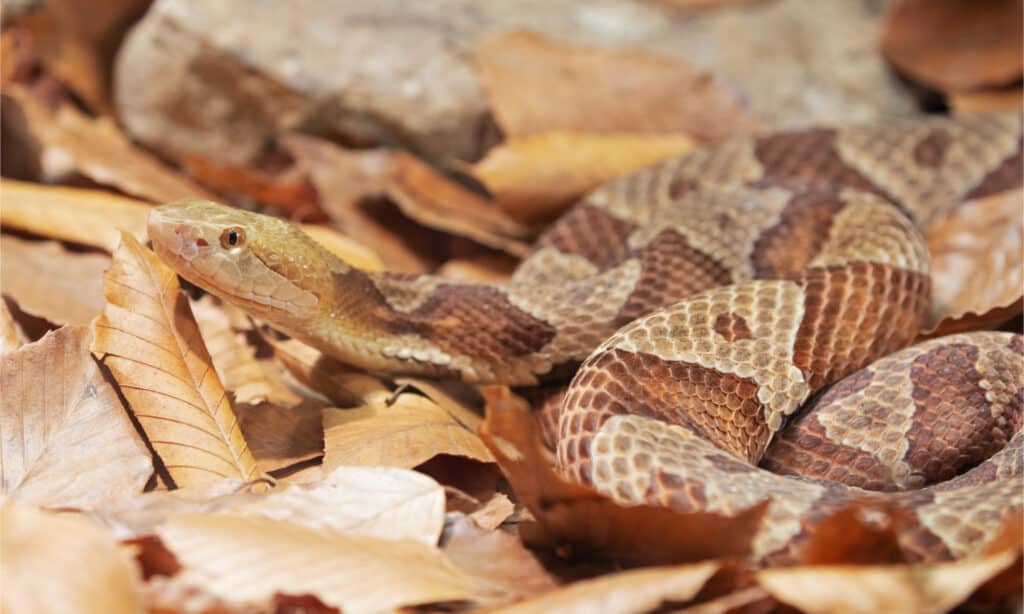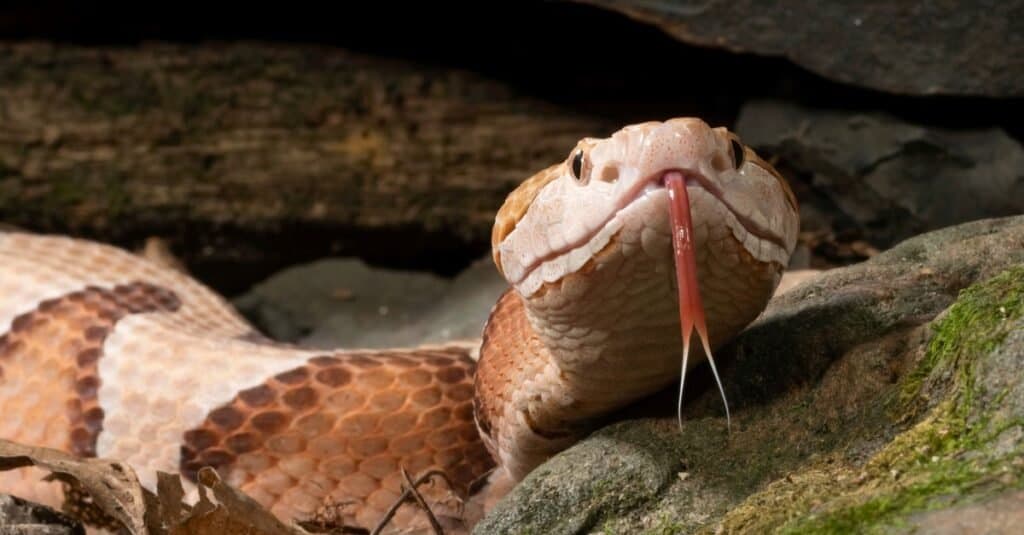Copperheads are widely recognized as the most common venomous snakes that people encounter in the southeastern United States, but just how far-ranging are these snakes? The “south” is generally considered to be anything south of the Mason-Dixon Line, excluding people north from officially being “southerners.” Still, even though the northeastern part of the United States isn’t as warm as the south, can snakes still live there? Today that is exactly what we are going to be exploring. Let’s discover if copperheads are in Massachusetts and, if they are, how often they bite. Let’s get started!
Do Copperheads live in Massachusetts?

Copperheads live in the southern parts of Massachusetts.
©DnDavis/Shutterstock.com
Although quite rare, copperheads are found in the state of Massachusetts.
There are multiple subspecies of copperhead in the United States, and Massachusetts is home to one of them; the northern copperhead. Overall, these snakes are common throughout most of the eastern United States, but they are rare to encounter in the state of Massachusetts. Massachusetts is one of the most northern states where these snakes can be found in.
Since Massachusetts is at the far edge of their range, they are listed as locally endangered, although that designation is state specific. With their endangered status, copperheads are illegal to kill or harass.
Identifying a Copperhead

The copperhead is copper-colored and covered in hourglass-shaped bands.
©iStock.com/David Kenny
Copperheads are rather easy to identify as they have distinctive patterns and colors that are generally consistent regardless of the subspecies. As their name suggests, copperheads are copper across their bodies, although some individuals are darker while others are more reddish or pinkish. They also have a banding pattern down their backs in the shape of an hourglass. The thick “reservoir” portions of the hourglass shapes are along the sides of the snake, while the thin portion is laid along their spine. The bands repeat from head to tail.
Additionally, copperheads have yellow or golden eyes shaped like cats with slitted pupils. They also have ridged eyebrow scales over their eyes that can give them a “mean” look. Their heads are flat and triangular, and they have distinctive pits behind their nostrils for heat sensing. These pits classify them as pit vipers, alongside cottonmouths and rattlesnakes.
Where do Copperheads live?
In Massachusetts, copperheads only inhabit a small area in the southern portion of the state. In the last 25 years, these snakes have only been documented in the Connecticut River Valley and in the Boston area. Within these regions, copperheads are quite variable when it comes to habitat. They are most often seen in forests and along basalt ridges. Additionally, they are almost always found near a water source, including rivers, swamps, ponds, and streams.
Nationally, copperheads are found as far west as Texas and as far east as the coast. Their southern range starts in Georgia and extends north into New York and Massachusetts. Like in Massachusetts, copperheads generally live around forests and rocky ridges, preferably near a water source. Their camouflage is perfect for leaf-covered forest floors.
When do copperheads come out in Massachusetts?
Since Massachusetts is on the northern edge of their habitat, copperheads in this region brumate (hibernation for reptiles) the longest. As a general rule, copperheads begin their hibernation during the fall around October and leave their dens around April. The biggest factor in determining when they become inactive is the temperature.
When copperheads go into their hibernacula (dens), they always leave the opening facing the south, southeast, or southwest in order to sun themselves during the spring and fall when temperatures allow it.
How dangerous are Copperheads?

Although copperheads are venomous, they aren’t deadly in most cases.
©Joe McDonald/Shutterstock.com
There are two venomous snakes in Massachusetts, the copperhead and the timber rattlesnake. While both are venomous, the copperhead is by far the least dangerous of the two. In fact, copperheads are the least dangerous of all pit vipers. The cottonmouth is slightly more dangerous, and most species of rattlesnake are significantly more dangerous. Although many people are fearful of snakes in general, let alone copperheads, they aren’t inclined to bite unless bothered or faced with a threat. In fact, many copperhead bites are dry, and little to no venom is even injected.
The most common reason people are bitten is that humans don’t see the camouflaged snake and reach into its space unknowingly. The snake, fearing a predator, will quickly lash out and bite. If a human is bitten, common symptoms include pain, tingling, throbbing, swelling, and severe nausea. Fatalities are extremely rare and usually the result of an allergic reaction, not the standard venom response.
How often are people bitten by Copperheads?

About 3,000 people are bitten by copperhead each year, with virtually all of them being non-fatal.
©Dennis W Donohue/Shutterstock.com
In the eastern United States, copperhead bites are the most common of any venomous snake. As previously mentioned, this is mostly due to their preference for hiding and staying camouflaged as opposed to hissing or rattling their tail, as other species do. Thankfully, copperhead bites aren’t deadly, although they are serious. Each year, an estimated 3,000 people are bitten by copperheads in the United States.
The photo featured at the top of this post is © Scott Delony/Shutterstock.com
Discover the "Monster" Snake 5X Bigger than an Anaconda
Every day A-Z Animals sends out some of the most incredible facts in the world from our free newsletter. Want to discover the 10 most beautiful snakes in the world, a "snake island" where you're never more than 3 feet from danger, or a "monster" snake 5X larger than an anaconda? Then sign up right now and you'll start receiving our daily newsletter absolutely free.
Thank you for reading! Have some feedback for us? Contact the AZ Animals editorial team.






